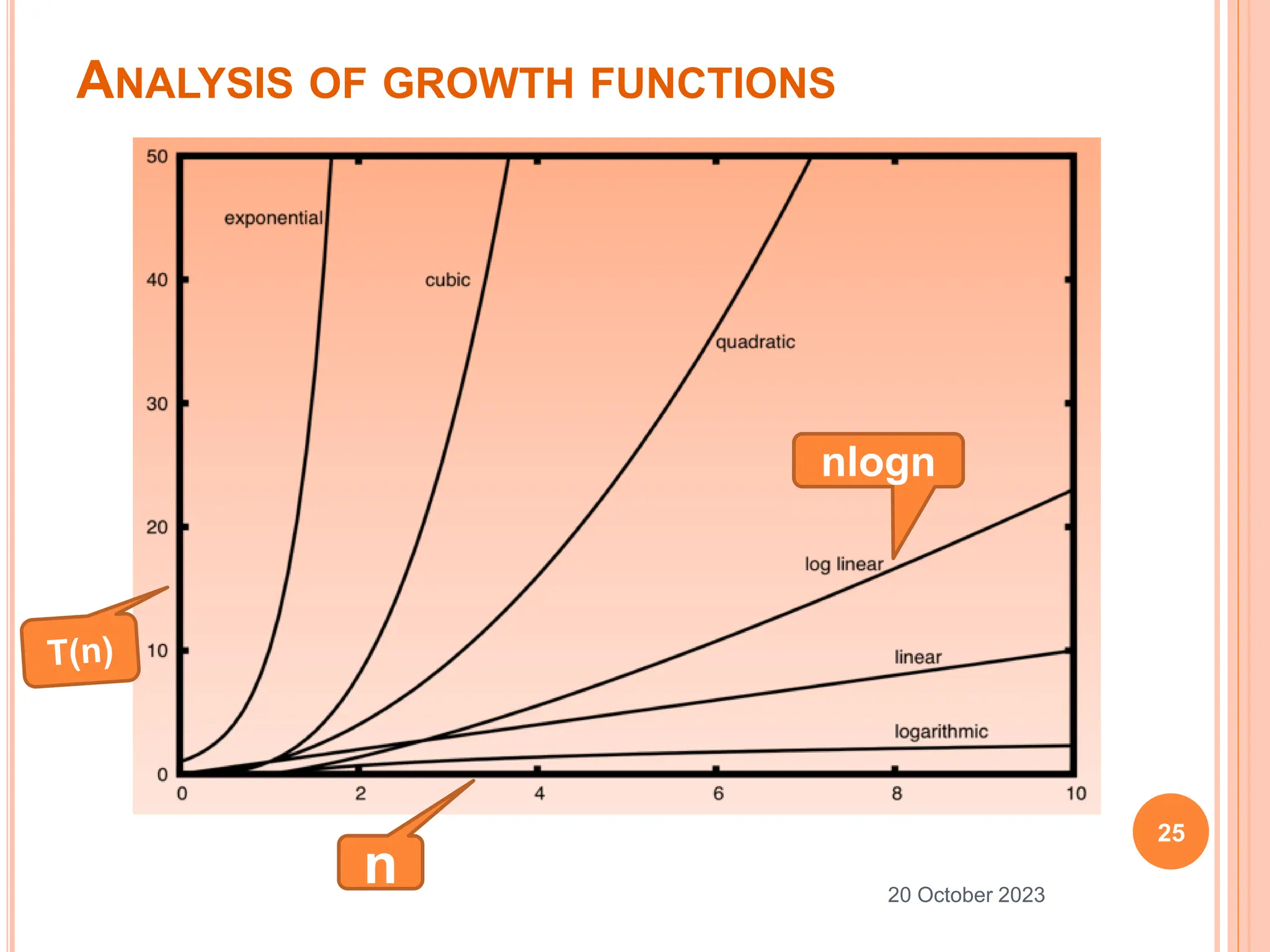The document discusses simple sorting and searching algorithms. It describes selection sort, bubble sort, and insertion sort, which are all O(n^2) elementary sorting algorithms best for small lists. It also covers linear/sequential search, which has O(n) complexity, and binary search, which has optimal O(log n) complexity but requires a sorted list. Pseudocode and examples are provided for each algorithm.
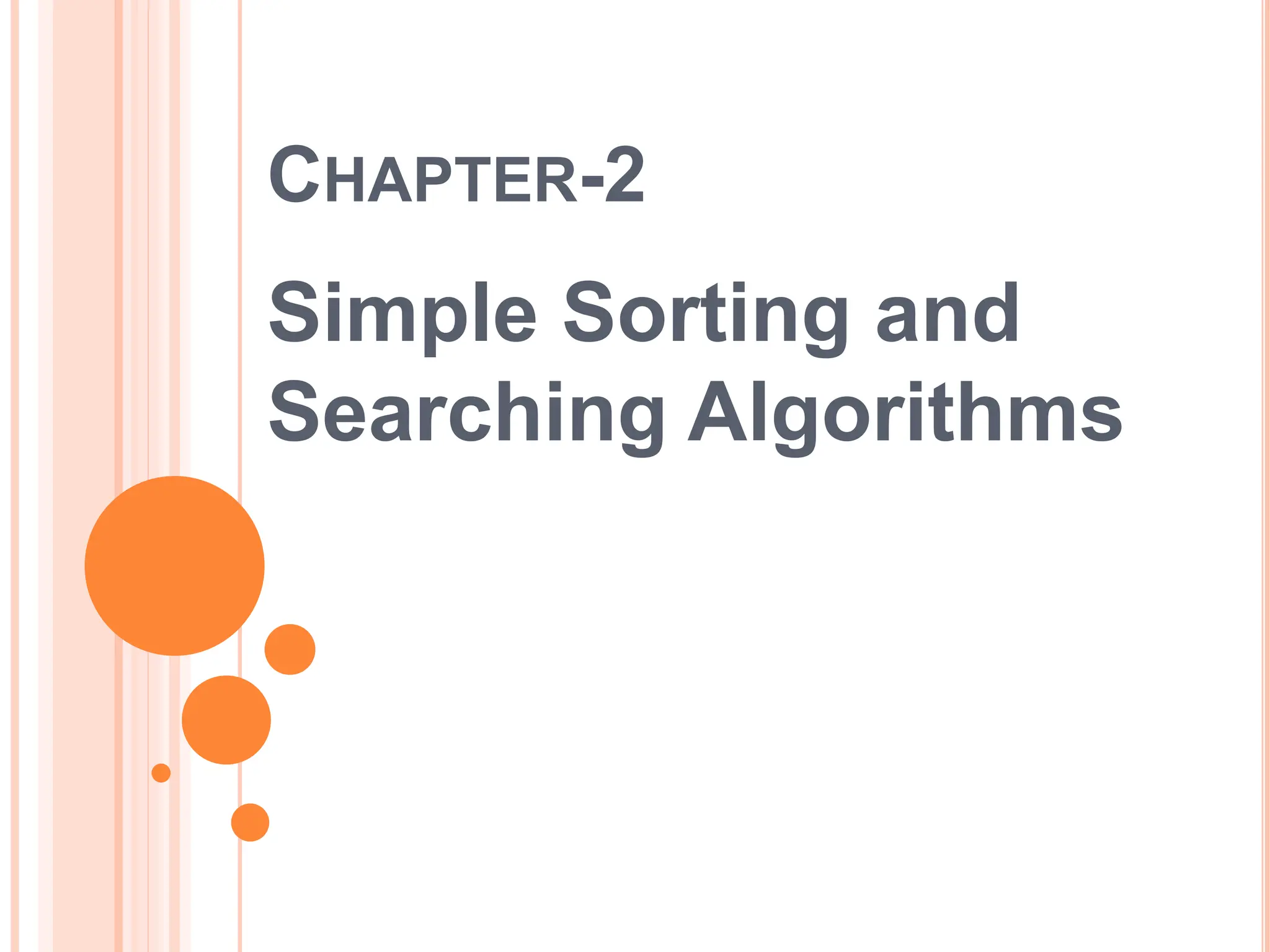
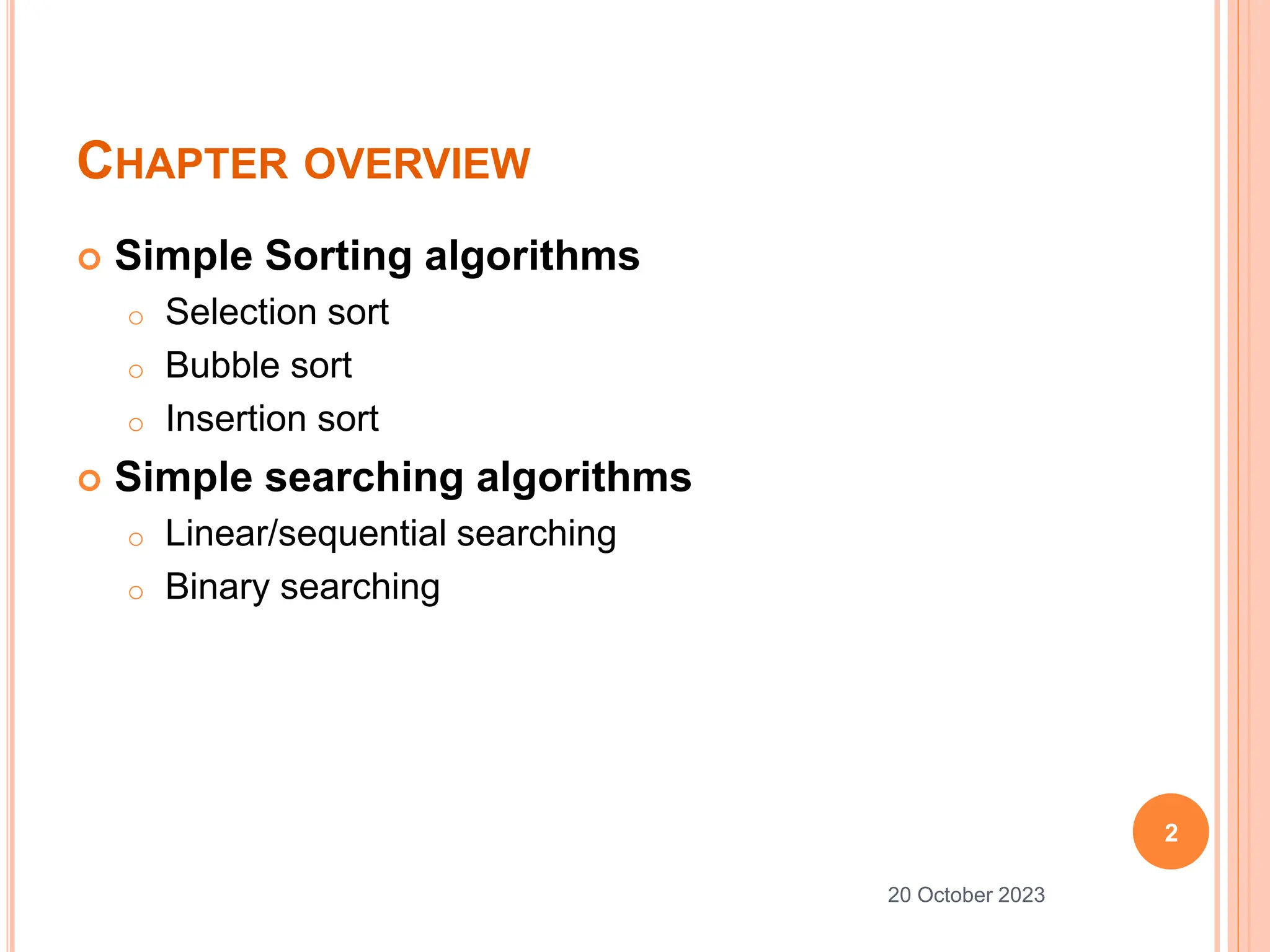
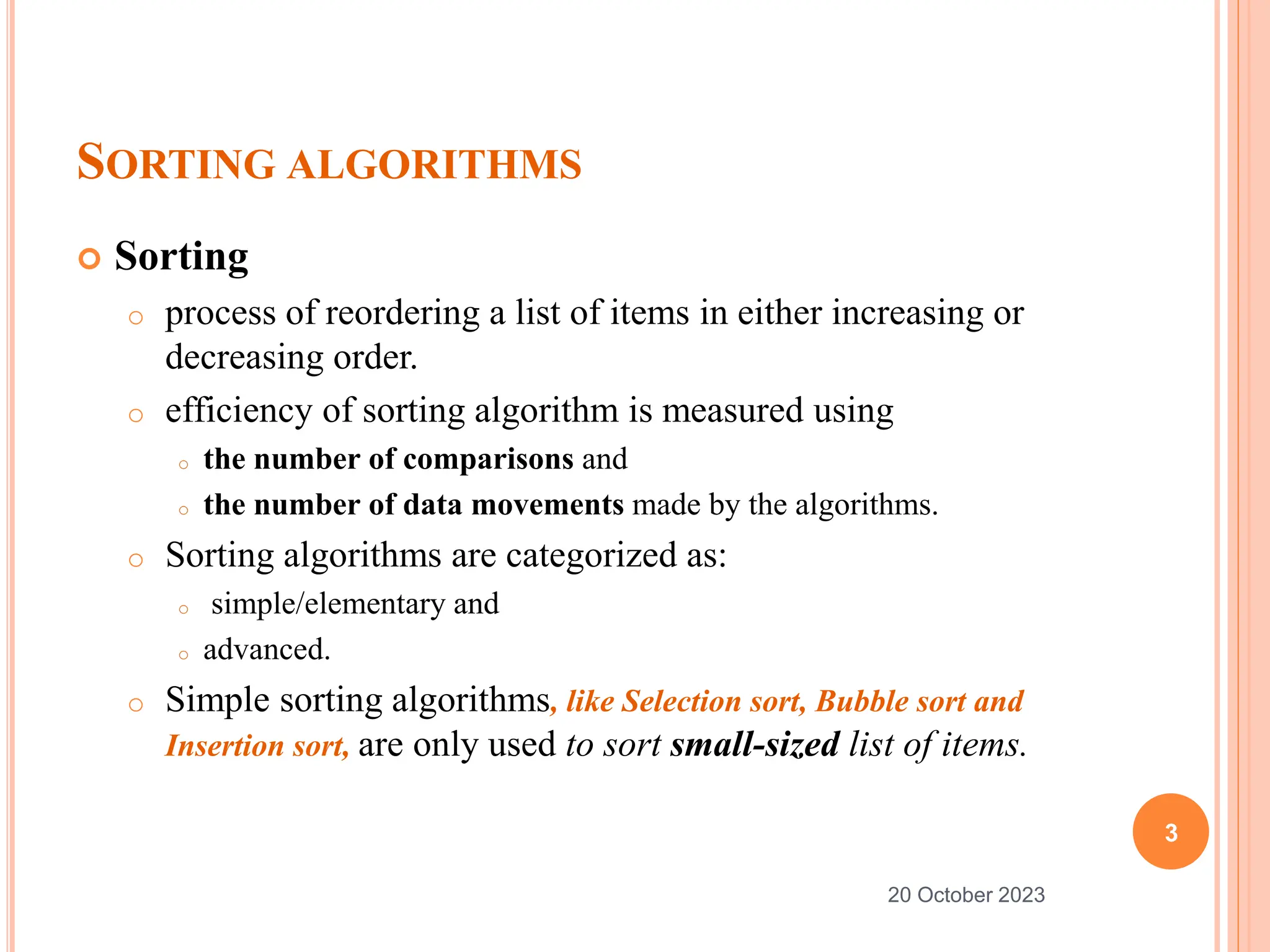
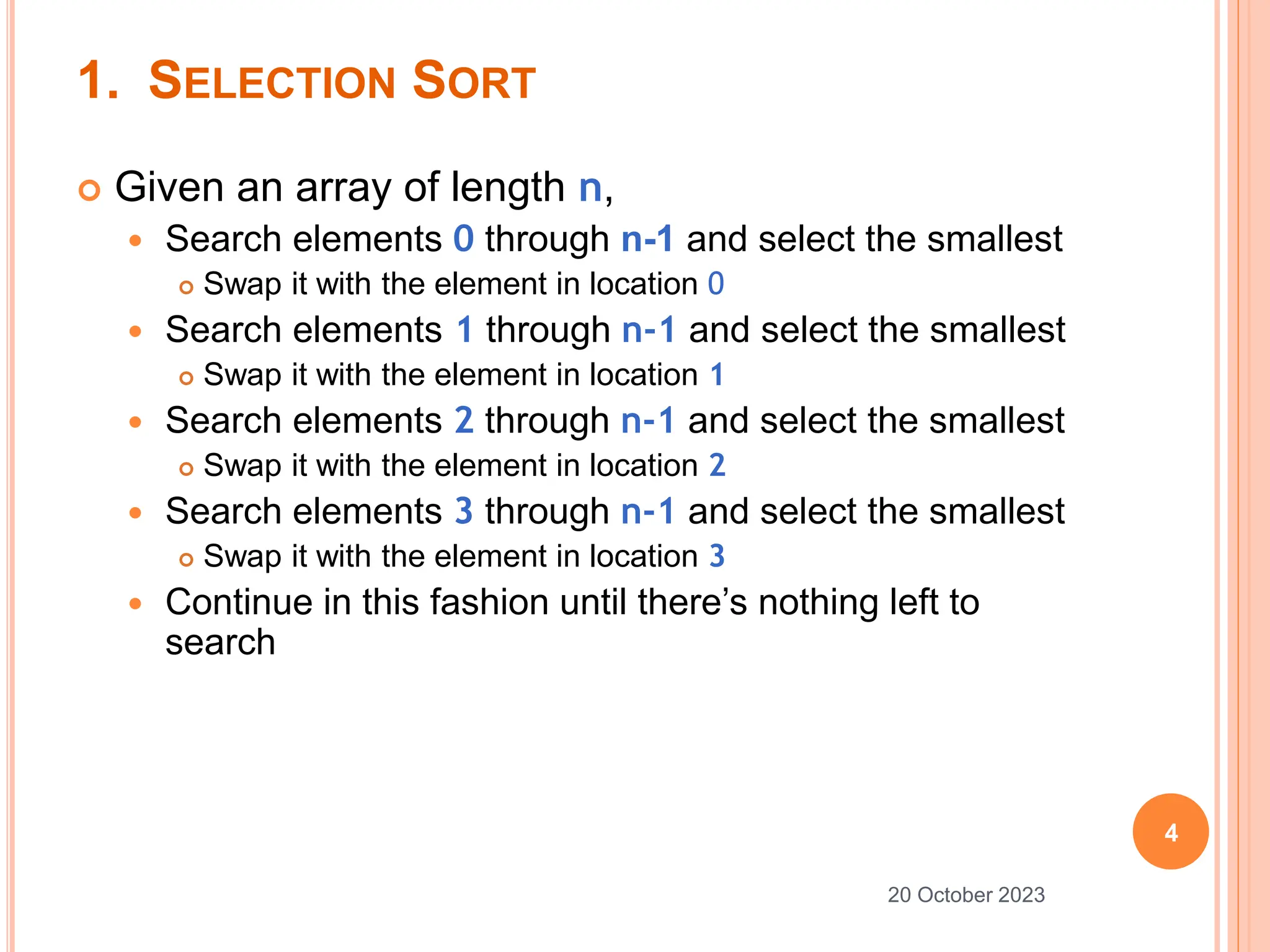
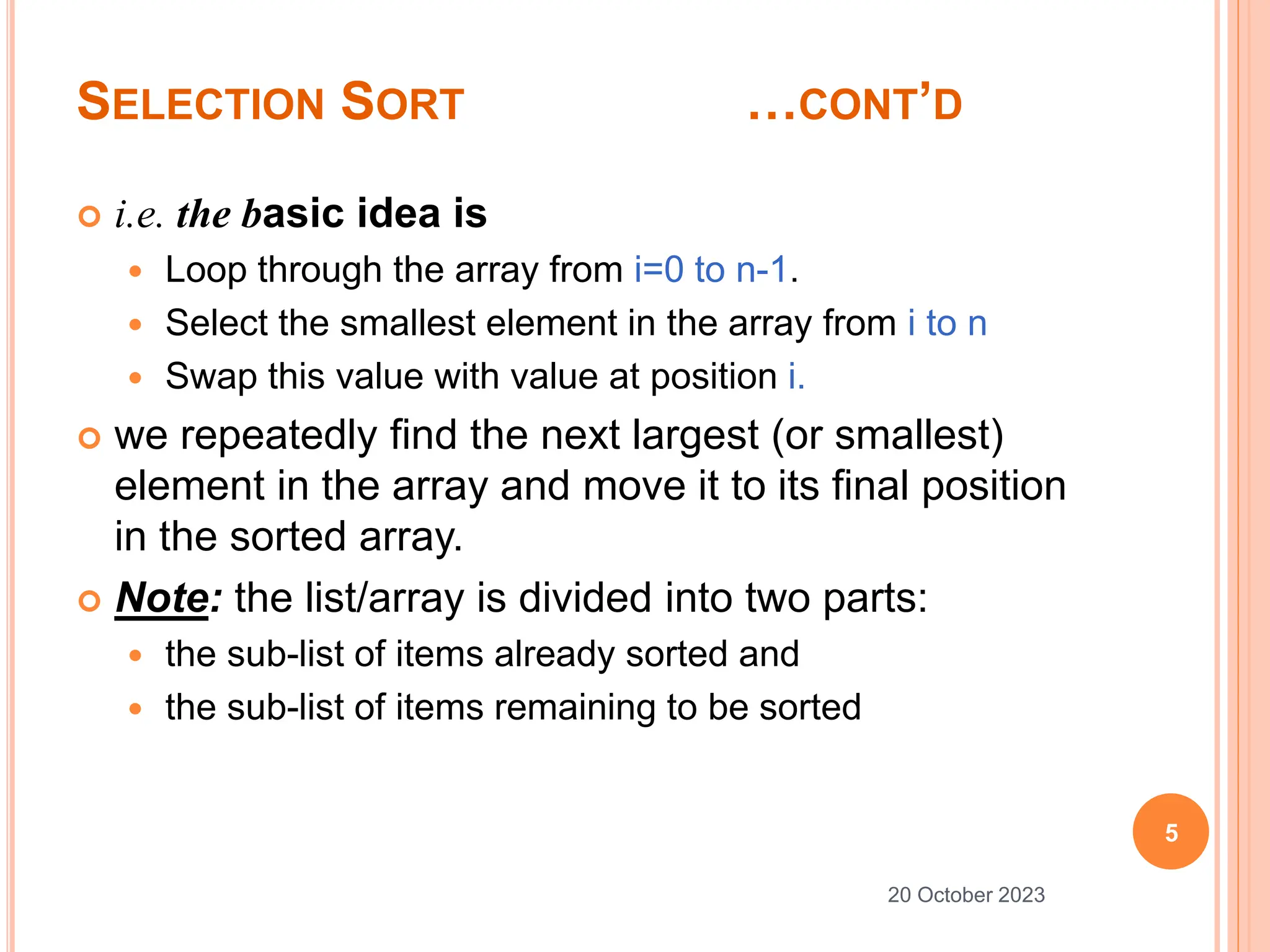
![SELECTION SORT EXAMPLE …CONT’D
Analysis:
The outer loop executes n-1 times
The inner loop executes about n(n-1)/2
times on average (from n to 2 times)
Work done in the inner loop is constant
(swap two array elements)
Time required is roughly (n-1)*[n(n-1)/2]
You should recognize this as O(n2)
i.e.
How many comparisons?
(n-1)+(n-2)+…+1 = O(n2)
How many swaps?
n = O(n)
6
20 October 2023
7 2 8 5 4
2 7 8 5 4
2 4 8 5 7
2 4 5 8 7
2 4 5 7 8](https://image.slidesharecdn.com/chapter-2-231020122611-1a491b8f/75/Chapter-2-pptx-6-2048.jpg)
![CODE FOR SELECTION SORT …CONT’D
void selectionSort(int[] a)
{
int outer, inner, min;
for (outer = 0; outer < a.length - 1; outer++)
{
min = outer;
for (inner = outer + 1; inner < a.length; inner++)
{
if (a[inner] < a[min])
{
min = inner;
}
}
int temp = a[outer];
a[outer] = a[min];
a[min] = temp;
}
}//end of function
7
20 October 2023](https://image.slidesharecdn.com/chapter-2-231020122611-1a491b8f/75/Chapter-2-pptx-7-2048.jpg)

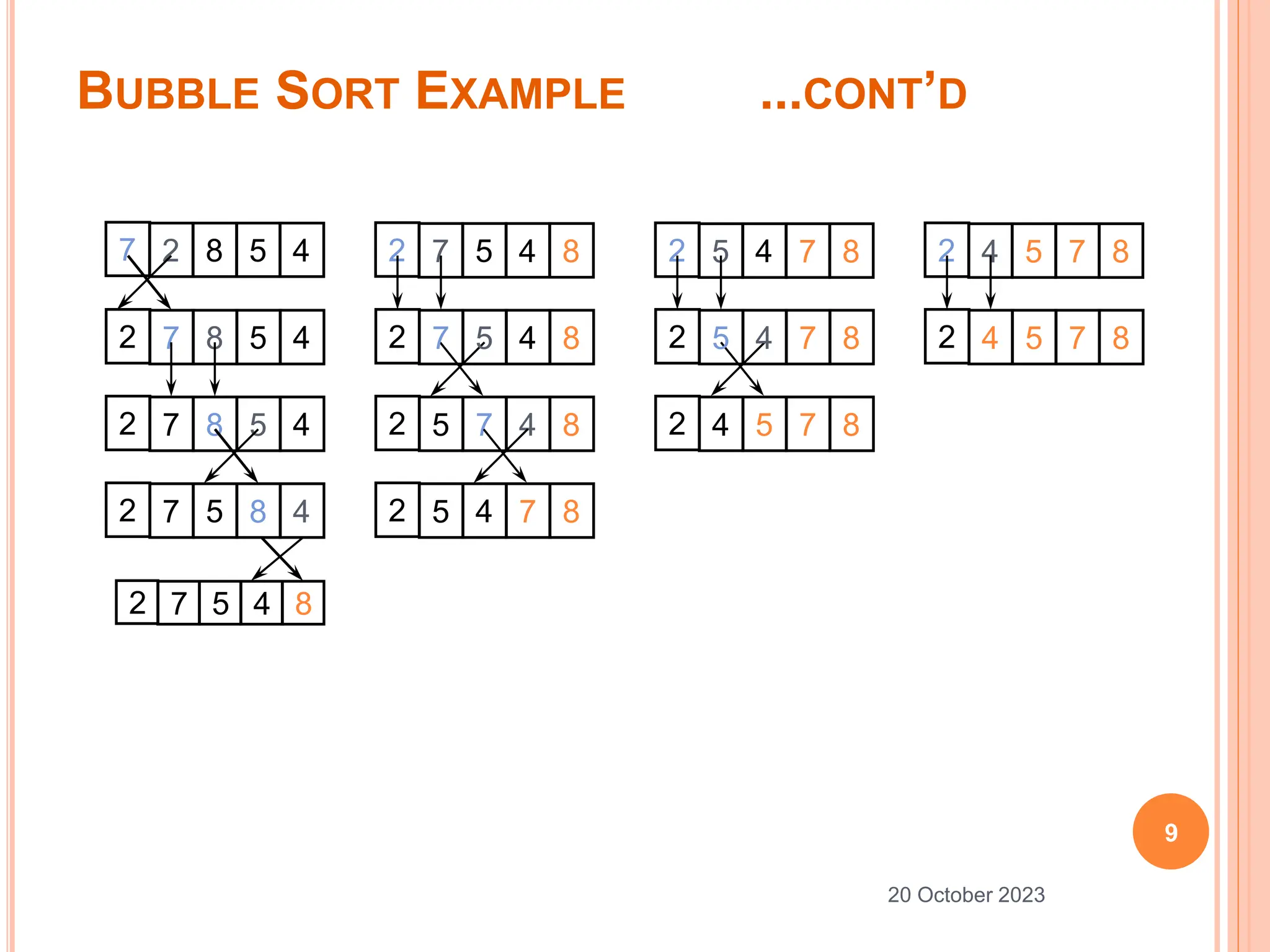
![CODE FOR BUBBLE SORT ...CONT’D
void bubbleSort(int[] a)
{
int outer, inner;
for (outer = a.length - 1; outer > 0; outer--) //counts down
{
for (inner = 0; inner < outer; inner++)
{
if (a[inner] > a[inner + 1])
{
int temp = a[inner];
a[inner] = a[inner + 1];
a[inner + 1] = temp;
}
}
}
}
10
20 October 2023](https://image.slidesharecdn.com/chapter-2-231020122611-1a491b8f/75/Chapter-2-pptx-10-2048.jpg)
![ANALYSIS FOR BUBBLE SORT ...CONT’D
Let n = a.length = size of the array
The outer loop is executed n-1 times
Each time the outer loop is executed, the inner loop is executed
Inner loop executes n-1 times at first, linearly dropping to just
once
On average, inner loop executes about n(n-1)/2 times for
each execution of the outer loop
In the inner loop, the comparison is always done (constant
time), the swap might be done (also constant time)
Result is (n-1) * [ n(n-1)/2 ] + k, that is, O(n2)
i.e.
How many comparisons?
(n-1)+(n-2)+…+1= O(n2)
How many swaps?
(n-1)+(n-2)+…+1= O(n2)
11
20 October 2023](https://image.slidesharecdn.com/chapter-2-231020122611-1a491b8f/75/Chapter-2-pptx-11-2048.jpg)

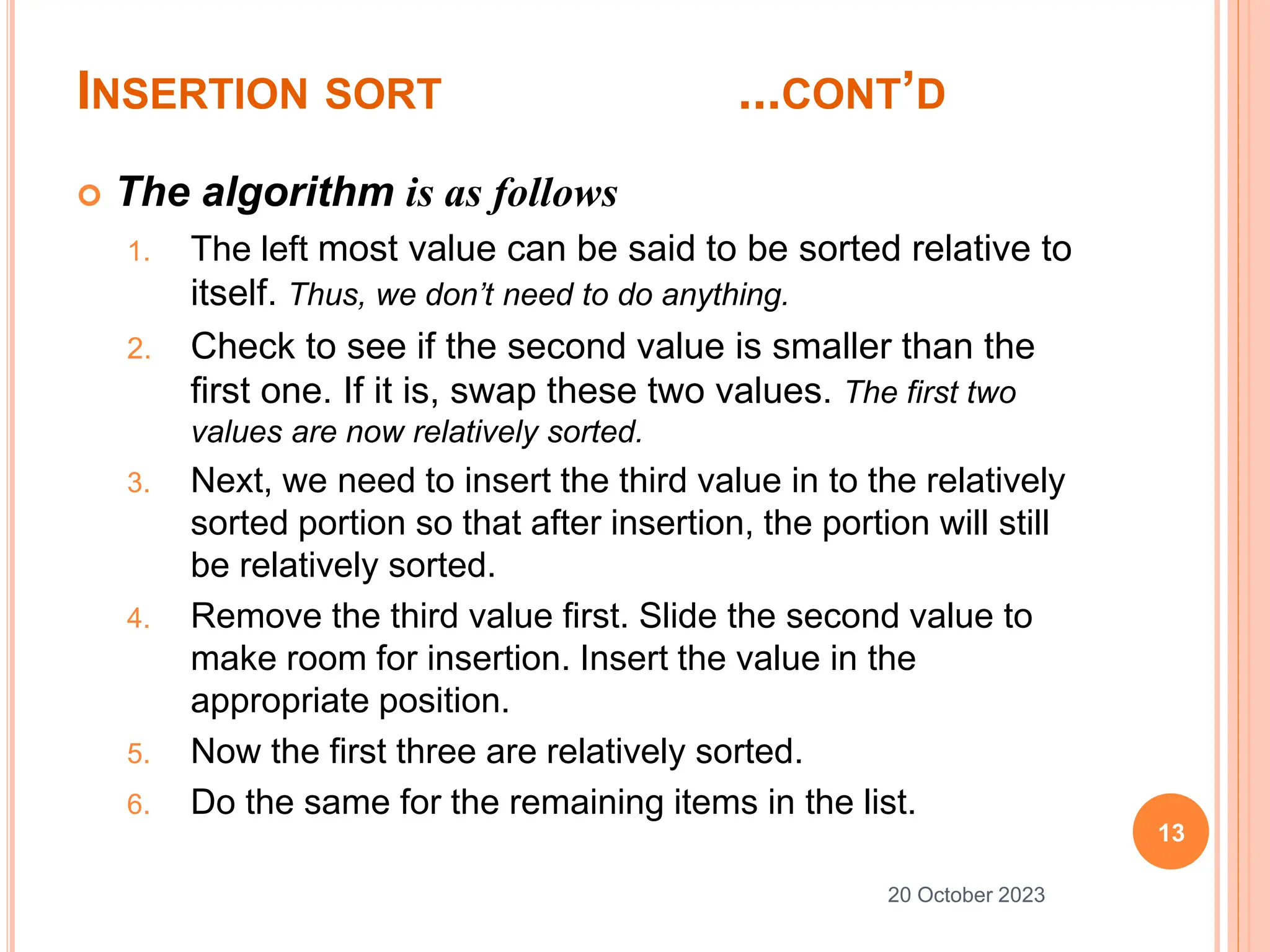

![CODE FOR INSERTION SORT ...CONT’D
void insertionSort(int[] array)
{
int inner, outer;
for (outer = 1; outer < array.length; outer++)
{
int temp = array[outer];
inner = outer;
while (inner > 0 && array[inner - 1] >= temp)
{
array[inner] = array[inner - 1];
inner--;
}
array[inner] = temp;
}
} 15
20 October 2023](https://image.slidesharecdn.com/chapter-2-231020122611-1a491b8f/75/Chapter-2-pptx-15-2048.jpg)
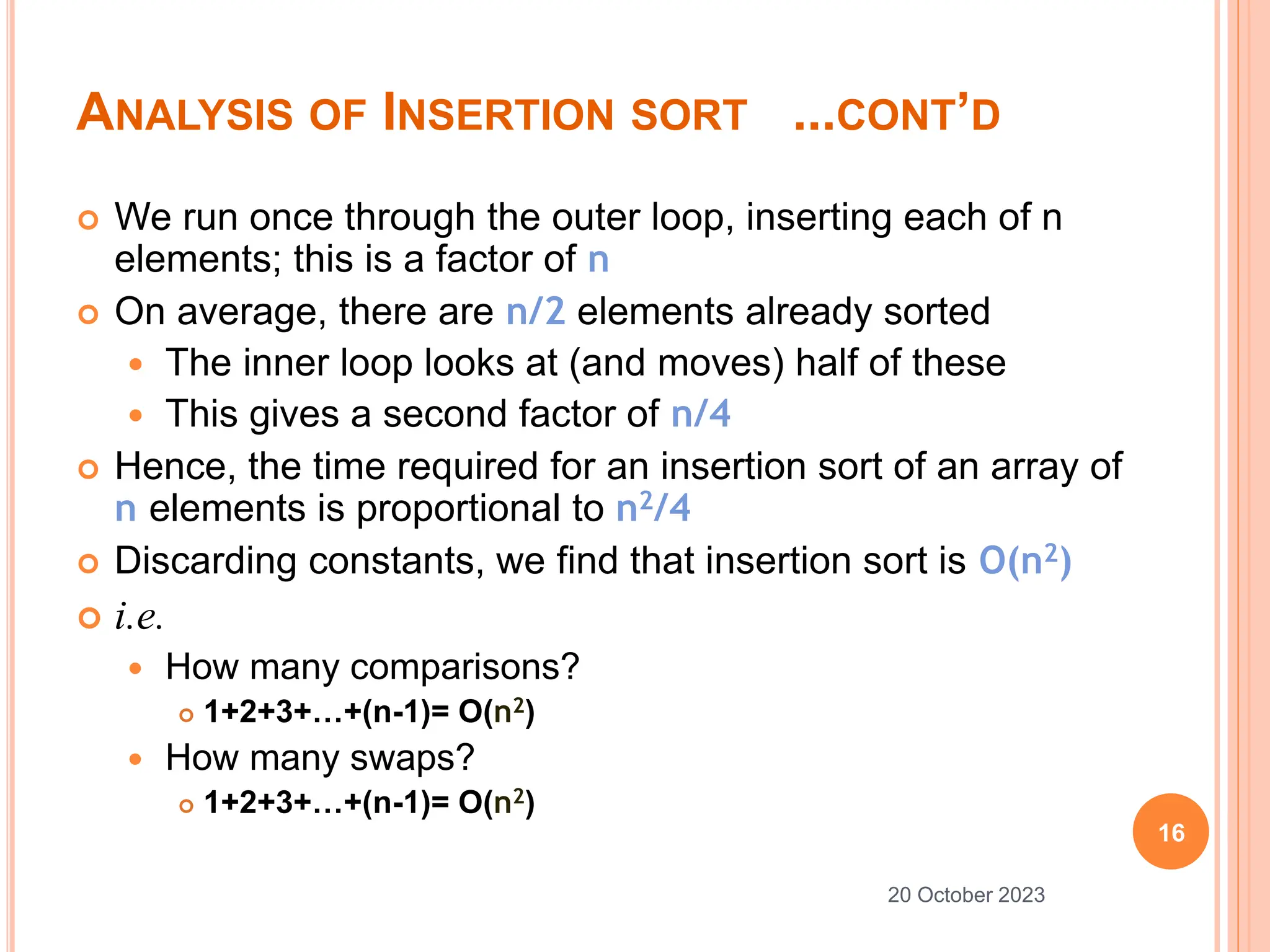

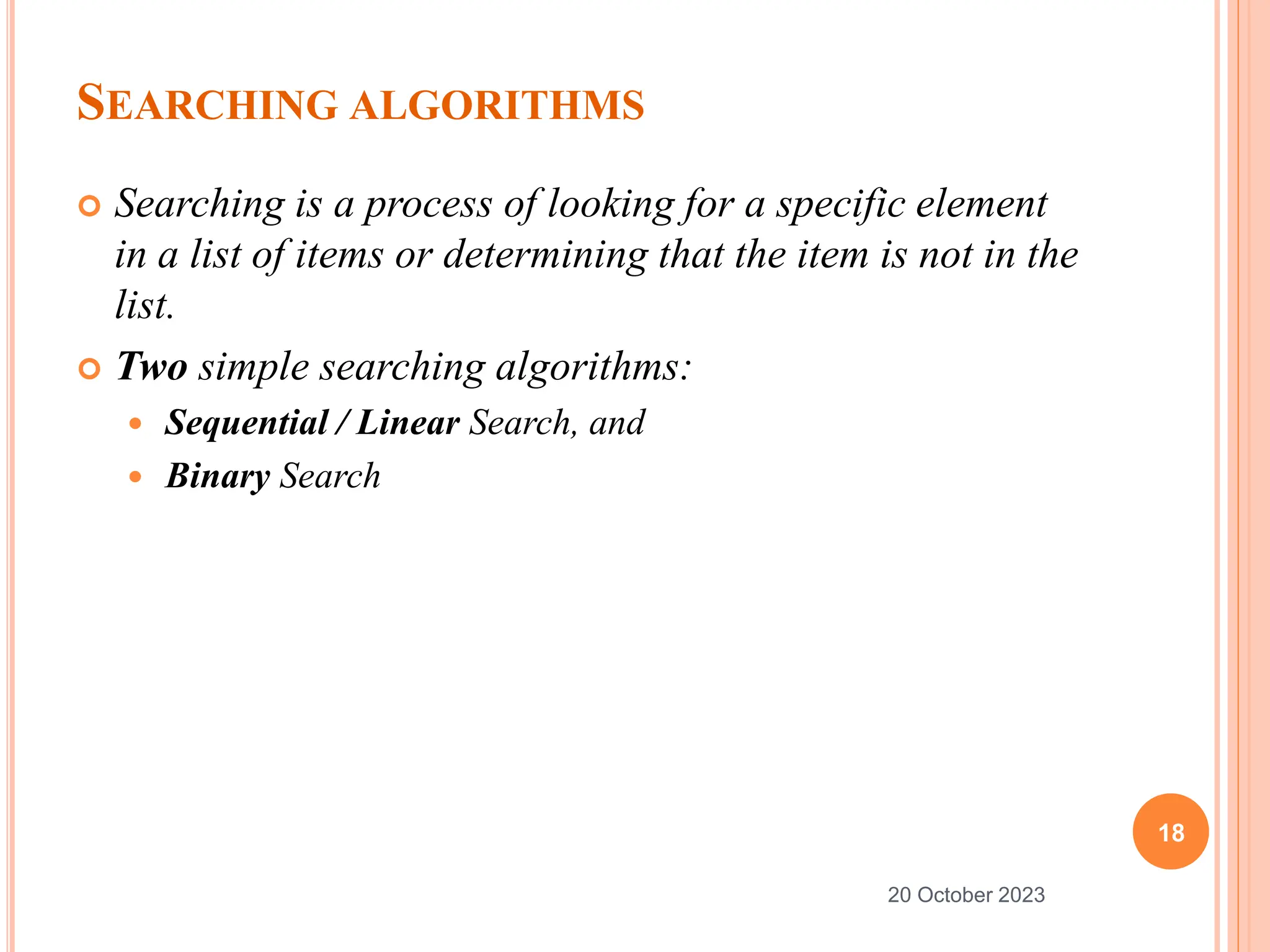
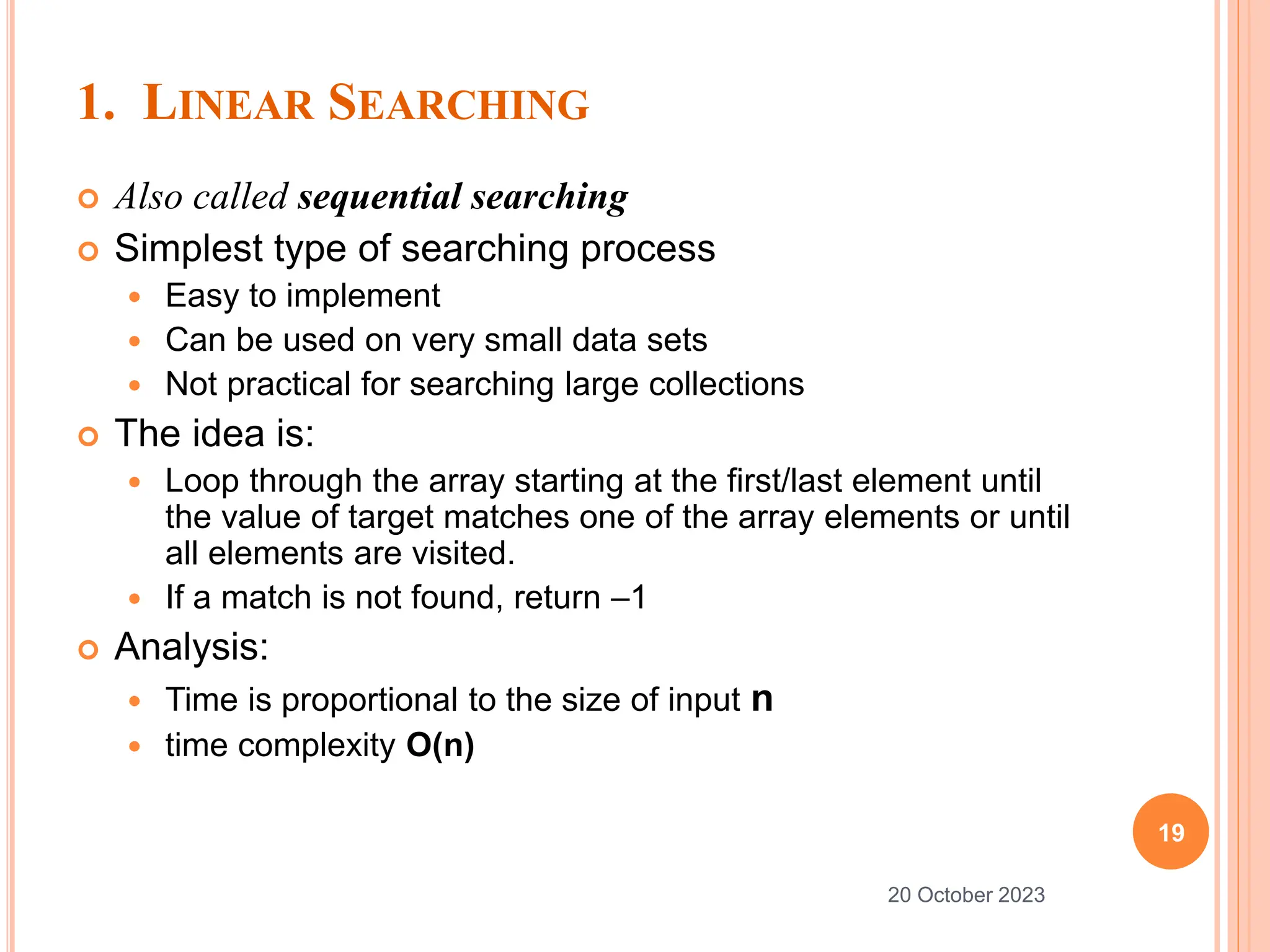
![LINEAR SEARCHING …CONT’D
Algorithm for Sequential/Linear Search
1. Initialize searcharray, key/number to be searched,
length
2. Initialize index=0,
3. Repeat step 4 till index<=length.
4. if searcharray[index]=key
return index
else
increment index by 1.
20
20 October 2023](https://image.slidesharecdn.com/chapter-2-231020122611-1a491b8f/75/Chapter-2-pptx-20-2048.jpg)
![IMPLEMENTATION OF LINEAR SEARCHING …CONT’D
int linearSearch(int list[ ], int key)
{
int index=0;
int found=0;
do
{
if(key==list[index])
found=1;
else
index++;
}while(found==0&&index<n);
if(found==0)
index=-1;
return index;
}
21
20 October 2023](https://image.slidesharecdn.com/chapter-2-231020122611-1a491b8f/75/Chapter-2-pptx-21-2048.jpg)
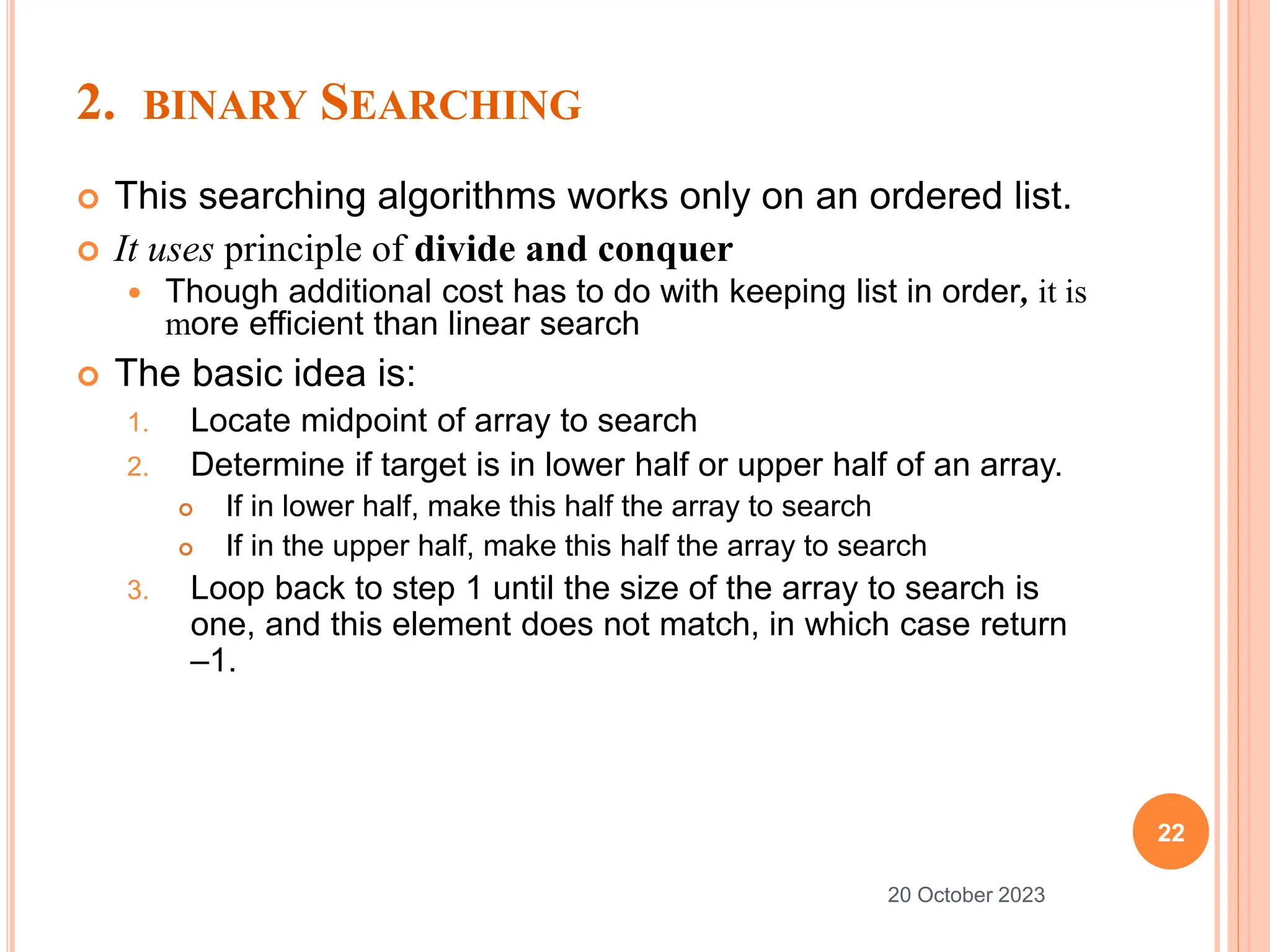
![BINARY SEARCHING …CONT’D
Analysis:
computational time for this algorithm is proportional to log2n
Therefore the time complexity is O(log n)
Algorithm for Binary Search
1. Initialize an ordered array, searcharray, key, length.
2. Initialize left=0 and right=length
3. Repeat step 4 till left<=right
4. Middle =(left + right) / 2
5. if searcharray[middle]=key
Search is successful
return middle.
else
if key<searcharray[middle]
right=middle - 1
else
left=middle + 1.
23
20 October 2023](https://image.slidesharecdn.com/chapter-2-231020122611-1a491b8f/75/Chapter-2-pptx-23-2048.jpg)
![IMPLEMENTATION OF BINARY SEARCHING …CONT’D
int Binary_Search(int list[ ],int k)
{
int left=0;
int right=n-1;
int found=0;
do{
mid=(left+right)/2;
if(key==list[mid])
found=1;
else{
if(key<list[mid])
right=mid-1;
else
left=mid+1;
}
}while(found==0&&left<right);
if(found==0)
index=-1;
else
index=mid;
return index;
} 24
20 October 2023](https://image.slidesharecdn.com/chapter-2-231020122611-1a491b8f/75/Chapter-2-pptx-24-2048.jpg)
